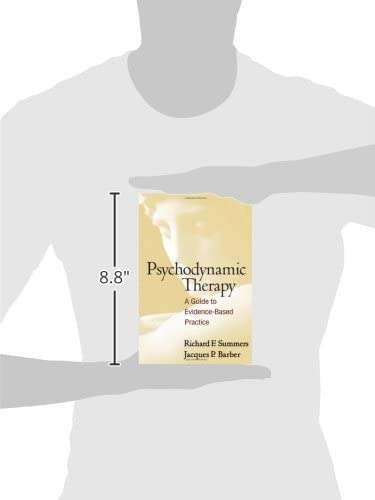P
resenting a pragmatic, evidence-based approach to conducting psychodynamic therapy, this engaging guide is firmly grounded in contemporary clinical practice and research. The book reflects an openness to new influences on dynamic technique, such as cognitive-behavioral therapy and positive psychology. It offers a fresh understanding of the most common problems for which patients seek help—depression, obsessionality, low self-esteem, fear of abandonment, panic, and trauma—and shows how to organize and deliver effective psychodynamic interventions. Special topics include ways to integrate individual treatment with psychopharmacology and with couple or family work.
See also , edited by Summers and Barber, which features 12 in-depth cases that explicitly illustrate the approach in this book.
resenting a pragmatic, evidence-based approach to conducting psychodynamic therapy, this engaging guide is firmly grounded in contemporary clinical practice and research. The book reflects an openness to new influences on dynamic technique, such as cognitive-behavioral therapy and positive psychology. It offers a fresh understanding of the most common problems for which patients seek help—depression, obsessionality, low self-esteem, fear of abandonment, panic, and trauma—and shows how to organize and deliver effective psychodynamic interventions. Special topics include ways to integrate individual treatment with psychopharmacology and with couple or family work.See also, edited by Summers and Barber, which features 12 in-depth cases that explicitly illustrate the approach in this book.
Richard F. Summers, MD, is Clinical Professor and Co-Director of Residency Training in the Department of Psychiatry at the University of Pennsylvania School of Medicine, and a faculty member of the Philadelphia Center for Psychoanalysis. Dr. Summers’s clinical interests focus on combined psychotherapeutic and psychopharmacological treatment of mood and anxiety disorders, and adult life cycle development. His research interests include the contemporary revision of the theory and technique of psychodynamic psychotherapy, new approaches to psychotherapy training and education, comprehensive psychodynamic formulation, and positive psychology. Dr. Summers is the recipient of numerous teaching awards, including awards from the University of Pennsylvania, the Psychoanalytic Center of Philadelphia, and the Philadelphia Psychiatric Society. He has been named a “Top Doc” by Philadelphia magazine and is past president of the American Association of Directors of Psychiatric Residency Training.
Jacques P. Barber, PhD, ABPP, is Dean of the Derner Institute?of Advanced Psychological Studies at Adelphi University in Long Island. He is also Professor Emeritus of Psychology in the Department of Psychiatry at the University of Pennsylvania School of Medicine. He conducts research on the outcome and process of dynamic and cognitive therapies for depression, panic disorder, substance dependence, and personality disorders. He has also written extensively on the impact of the therapeutic alliance and therapists’ use of theoretically relevant interventions on the outcomes of various therapies. Dr. Barber is a past president of the Society for Psychotherapy Research.
Presenting a pragmatic, evidence-based approach to conducting psychodynamic therapy, this engaging guide is firmly grounded in contemporary clinical practice and research. The book reflects an openness to new influences on dynamic technique, such as cognitive-behavioral therapy and positive psychology. It offers a fresh understanding of the most common problems for which patients seek help–depression, obsessionality, low self-esteem, fear of abandonment, panic, and trauma–and shows how to organize and deliver effective psychodynamic interventions. Extensive case material illustrates each stage of therapy, from engagement to termination. Special topics include ways to integrate individual treatment with psychopharmacology and with couple or family work.
See also Practicing Psychodynamic Therapy: A Casebook, edited by Summers and Barber, which features 12 in-depth cases that explicitly illustrate the approach in this book.
“This is the best book on psychotherapy that this former training director has ever read. It is rooted in both 21st-century science and the wisdom of psychiatry over the past two centuries. Students will value its lucidity, positivity, and common sense.”–George E. Vaillant, MD, Department of Psychiatry, Harvard Medical School “At last, we have the definitive book on psychodynamic therapy. The authors weave together traditional psychodynamic strategies and techniques with up-to-date developments in the field. The chapters are extremely well written, containing clinical examples that illustrate the strategies and techniques. The volume integrates psychotherapy with couple and family therapy, positive psychology, and combined psychotherapy and psychopharmacology. I highly recommend this book to clinicians and students who want the latest on psychodynamic therapy.”–Aaron T. Beck, MD, University Professor Emeritus of Psychiatry, Perelman School of Medicine, University of Pennsylvania “This important work combines the wisdom of experienced therapists with current empirical research. The book includes thoughtful discussions of alliance, transference, and interpretation, along with newer understandings of narrative and trauma. Summers and Barber share what they know, based on systematic research; what they believe, based on clinical experience; and, especially, what works–the specific clinical strategies they have found to be helpful and effective.”–Robert Michels, MD, Walsh McDermott University Professor of Medicine and Psychiatry, Cornell University “This gem of a book fills an important gap in the dynamic therapy literature, incorporating cutting-edge research and conceptual advances while using jargon-free, experience-near language. The result is a scholarly, nuanced, and innovative work that will be highly useful for beginning clinicians, supervisors, and even experienced clinicians across all major theoretical orientations. Summers and Barber debunk outdated and stereotyped ideas about dynamic psychotherapy by describing in a clear, pragmatic manner the core principles and the unique aspects of a dynamic approach. The clinical examples are vivid and resonant, illustrating the added value of dynamic principles for understanding and intervening with patients. A ‘must read’!”–Kenneth N. Levy, PhD, Department of Psychology, Pennsylvania State University
“This timely, up-to-date, and remarkably useful book will be accessible to readers from a broad range of professional backgrounds. It will be of particular interest to therapists-in-training who are relatively unfamiliar with psychoanalytic theory and seek a hands-on guide that incorporates the latest developments in clinical thinking and research. At a time when many psychiatry residencies and clinical psychology graduate programs neglect to provide adequate training in this pivotal approach, the book provides a much-needed corrective. Summers and Barber convey the wisdom, clinical sophistication, and vitality of psychodynamic therapy in a way that speaks to the sensibilities and needs of a new generation of therapists. A wonderful contribution!”–Jeremy D. Safran, PhD, Professor and Director of Clinical Psychology, New School for Social Research
“An important book that is practical, evidence-based, and useful for the general psychiatrist.”
— Journal of Clinical Psychiatry
“The authors’ combined wealth of practical experience with clients, students, and research has led to the development of a useful model for practitioners, trainers, and students….The concepts and techniques of ‘pragmatic psychodynamic psychotherapy’ (PPP) are introduced by means of a case study. PPP involves clear diagnosis and case formulation, which is shared with the client and used to agree a focus for the work. Rather than the traditional ‘black screen,’ an active, warm, and engaged way of working is advocated….A very useful book for practitioners, students, and trainers alike.”
— Therapy Today
“The book’s value lies in its ability to function as a tool for engendering the growth and development of psychodynamic therapeutic competency….This book has enormous value to both students and advanced practitioners. We hope that this book is adopted by institutes, graduate programs, and medical schools as a promising text to teach psychodynamic psychotherapy as well as a means of enhancing its effectiveness and preserving its credibility.”
— Clinical Social Work Journal
“Summers and Barber focus the light of empirical evidence on this treatment and on its competitors in a clear, concise, and well organized format. This allows them to debunk prevalent myths about psychodynamic theory and practice….The authors organize the presentation of PPP to reflect the three phases of psychotherapy, opening, middle, and ending. They use jargon-free language and they weave clinical vignettes into the chapters in a way that makes difficult concepts readily accessible to learners. One reviewer, a psychiatry resident, found this work to be a very useful synthesis of disparate sources of information regarding psychodynamic theory and practice. The very concrete examples in the clinical vignettes and the tables of key principles made it effortless to assimilate the concepts outlined in the text. Reading this work helped him shape his practice and encouraged him to use psychodynamic psychotherapy with a variety of patients….It is a guide to a mysterious and sometimes difficult area of mental health care. It presents a model of psychodynamic therapy to which a novice can relate and which he or she can safely implement, while leaving ample room for the development of an individuated personal technique….We recommend this book to supervisors and their students.”
— Journal of the American Academy of Psychoanalysis and Dynamic Psychiatry
“Will serve as a resource for practicing, teaching, and investigating psychotherapy. For the newcomer [the authors] offer a comprehensive framework for approaching the patient in actual clinical practice. For seasoned practitioners it offers a refocused perspective on ongoing therapeutic work. For the teacher the text provides an excellent outline for focusing on the clinical situation. For the researcher it offers a framework that lends itself to use as a research manual.”
— Journal of the American Psychoanalytic Association
“Throughout the book, detailed case studies are presented which help explain the ideas of psychodynamic theory and practice. Each individual’s tale of therapy is encapsulating and serves to contextualize the points made by the authors….This book is extremely well written and remarkably easy to pick up and read….It is very down to earth and provides a thorough, yet easy-to-digest knowledge of the development, and current developments of this highly useful technique….A brilliant and very informative book. Between the superbly detailed case studies and the respect for the core beliefs of psychodynamic theory, this book encompasses all there is to know about dynamic psychotherapy, in an accessible manner, and is an essential read for those wanting to know everything about psychodynamic theory in the present day.”
— Clinical Psychology Forum
“Summers and Barber’s text represents a careful investment in the psychodynamic tradition and its sensibilities, while also engendering a thoughtful openness to evolving developments in the mental health field….In this book, Summers and Barber fashion a general heuristic view to allow psychodynamic psychotherapy to be accessibly and effectively learned by beginning clinicians. This book’s value lies in its ability to function as a tool for engendering the growth and development of psychodynamic therapeutic competency….This book has enormous value to both students and advanced practitioners. We hope that this book is adopted by institutes, graduate programs and medical schools as a promising text to teach psychodynamic psychotherapy as well as a means of enhancing its effectiveness and preserving its credibility.”
— Clinical Social Work Journal
“An important book that is practical, evidence-based, and useful for the general psychiatrist.”— Journal of Clinical Psychiatry”The authors’ combined wealth of practical experience with clients, students, and research has led to the development of a useful model for practitioners, trainers, and students….The concepts and techniques of ‘pragmatic psychodynamic psychotherapy’ (PPP) are introduced by means of a case study. PPP involves clear diagnosis and case formulation, which is shared with the client and used to agree a focus for the work. Rather than the traditional ‘black screen,’ an active, warm, and engaged way of working is advocated….A very useful book for practitioners, students, and trainers alike.”— Therapy Today”The book’s value lies in its ability to function as a tool for engendering the growth and development of psychodynamic therapeutic competency….This book has enormous value to both students and advanced practitioners. We hope that this book is adopted by institutes, graduate programs, and medical schools as a promising text to teach psychodynamic psychotherapy as well as a means of enhancing its effectiveness and preserving its credibility.”— Clinical Social Work Journal”Summers and Barber focus the light of empirical evidence on this treatment and on its competitors in a clear, concise, and well organized format. This allows them to debunk prevalent myths about psychodynamic theory and practice….The authors organize the presentation of PPP to reflect the three phases of psychotherapy, opening, middle, and ending. They use jargon-free language and they weave clinical vignettes into the chapters in a way that makes difficult concepts readily accessible to learners. One reviewer, a psychiatry resident, found this work to be a very useful synthesis of disparate sources of information regarding psychodynamic theory and practice. The very concrete examples in the clinical vignettes and the tables of key principles made it effortless to assimilate the concepts outlined in the text. Reading this work helped him shape his practice and encouraged him to use psychodynamic psychotherapy with a variety of patients….It is a guide to a mysterious and sometimes difficult area of mental health care. It presents a model of psychodynamic therapy to which a novice can relate and which he or she can safely implement, while leaving ample room for the development of an individuated personal technique….We recommend this book to supervisors and their students.”— Journal of the American Academy of Psychoanalysis and Dynamic Psychiatry”Will serve as a resource for practicing, teaching, and investigating psychotherapy. For the newcomer [the authors] offer a comprehensive framework for approaching the patient in actual clinical practice. For seasoned practitioners it offers a refocused perspective on ongoing therapeutic work. For the teacher the text provides an excellent outline for focusing on the clinical situation. For the researcher it offers a framework that lends itself to use as a research manual.”— Journal of the American Psychoanalytic Association“Throughout the book, detailed case studies are presented which help explain the ideas of psychodynamic theory and practice. Each individual’s tale of therapy is encapsulating and serves to contextualize the points made by the authors….This book is extremely well written and remarkably easy to pick up and read….It is very down to earth and provides a thorough, yet easy-to-digest knowledge of the development, and current developments of this highly useful technique….A brilliant and very informative book. Between the superbly detailed case studies and the respect for the core beliefs of psychodynamic theory, this book encompasses all there is to know about dynamic psychotherapy, in an accessible manner, and is an essential read for those wanting to know everything about psychodynamic theory in the present day.”— Clinical Psychology Forum“Summers and Barber’s text represents a careful investment in the psychodynamic tradition and its sensibilities, while also engendering a thoughtful openness to evolving developments in the mental health field….In this book, Summers and Barber fashion a general heuristic view to allow psychodynamic psychotherapy to be accessibly and effectively learned by beginning clinicians. This book’s value lies in its ability to function as a tool for engendering the growth and development of psychodynamic therapeutic competency….This book has enormous value to both students and advanced practitioners. We hope that this book is adopted by institutes, graduate programs and medical schools as a promising text to teach psychodynamic psychotherapy as well as a means of enhancing its effectiveness and preserving its credibility.”— Clinical Social Work Journal




